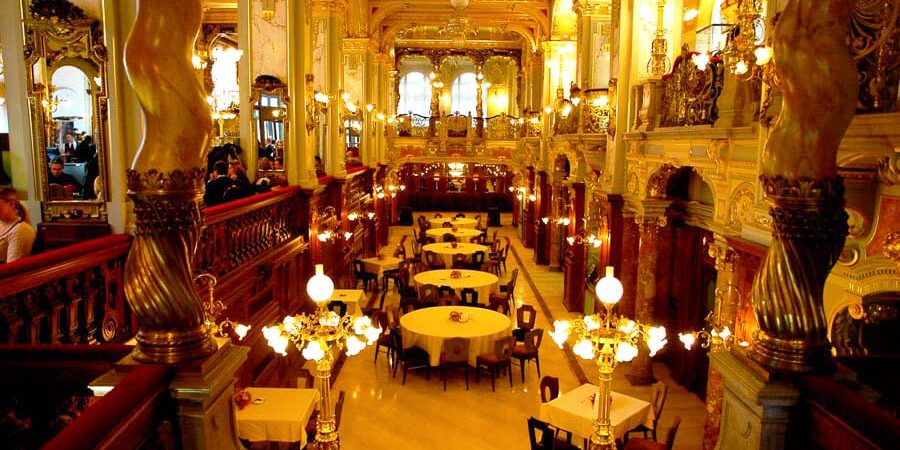Cafes are important elements in the lifestyle of Europeans. Coffee was brought in Europe by the Turks of the Ottoman Empire in 1683 among the army. The spread of this intense new flavor is datable at the end of the 1600’s. Coffee became a trend in the rich European families and ended up being a moment of gathering for poets, artists, writers and musicians. It is impossible to talk about all the historic cafes that still shine in the big European cities. But here is our list of the 10 most beautiful cafes in Europe. Some are less well known but remain incredible. While planning your future trip to Europe, I definitely recommend you keep in mind some of these atmospheric cafes: A real escape guaranteed!
- First opened in 1822
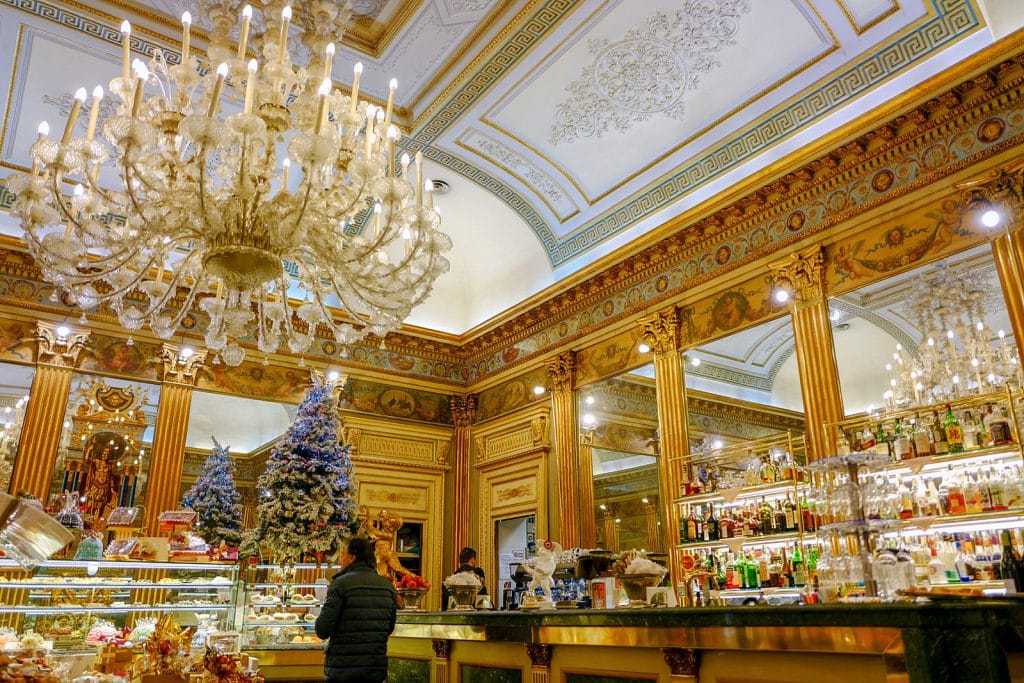
Caffè San Carlo can be counted among the most iconic European cafes as it’s been a meeting place for writers for centuries. This is where French novelist and author of The Three Musketeers, Alexandre Dumas, tasted his first bicerin, a unique hot beverage created from layers of espresso, drinking chocolate and milk.
One of the most distinguished cities in Italy, Turin was the Kingdom’s first capital (before Florence and Rome) and attracted Europe’s literary and political community as a result. Several grand cafes were established to host these noteworthy visitors, none more beautiful than Caffè San Carlo. The building sits in the famous Piazza San Carlo, right in the heart of Turin, where you can wander around and admire the city’s stately architecture. The interior is richly decorated with ornate gold-leaf mirror, marble and velvet.
Sitting inside the cafe and sipping on a glass of the city’s traditional hot drink is one of the things to do in Turin for your bucket list.
- First opened in 1720
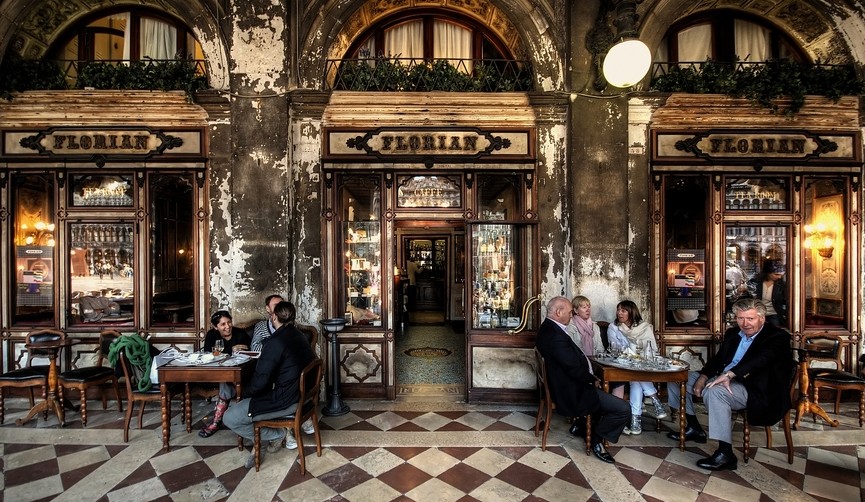
Caffè Florian in Venice is considered to be the oldest café in Italy, if not the world. Famous patrons of the two-room café include Goethe and the legendary lothario Casanova. Today Caffe Florian has huge displays of diverse artwork that grace the walls, ranging from comic strips to classical oil paintings. Hosting the world-renowned La Bienniale de Venezia art festival, this café is the perfect place to indulge in some Italian culture as well as enjoying some of the finest coffee in Europe.
The Italians are famed for their coffee, so there really is no better place to grab an authentic espresso or macchiato. The Italians adapted coffee to be drank in all manner of variations, such as with steamed or frothed milk, cocoa powder or the occasional shot of liqueur. Coffee then made its way overseas to South America in 1727, but nothing quite beats a coffee served in one of Italy’s most legendary cafés.
- First opened in 1860

Caffè Gambrinus is a cafe located in the famous Piazza del Plebiscito in Naples. Its name is inspired by Joannus Primus, King of Flanders, legendary inventor of beer. Caffè Gambrinus was founded by the entrepreneur Vincenzo Apuzzo who knew how to surround himself with the best teams of pastry chefs and ice cream parlors of the time. From then on, the Gambrinus immediately obtained a huge success as well as the benevolence of the royal family and the recognition by decree of “Supplier of the Royal House”.
Over the years, its golden salons have welcomed many personalities from all countries, who then became loyal customers such as: Gabriele D’Annunzio, Benedetto Croce, Matilde Serao, Eduardo Scarpetta, Totò, Eduardo De Filippo, Ernest Hemingway, Oscar Wilde, Jean-Paul Sartre who all contributed, through a poetry, a dedication or a photo to immortalize the place.
Today, the Gambrinus has regained its former splendor, it is one of the most frequented places in Naples by artists and intellectuals as well as by tourists. The Presidents of the Republic Francesco Cossiga, Oscar Luigi Scalfaro, Carlo Azeglio Ciampi and Giorgio Napolitano as well as the Presidents of the Council Romano Prodi and Silvio Berlusconi have stopped there several times to enjoy a coffee, during their stays in town.
- First opened in 1921
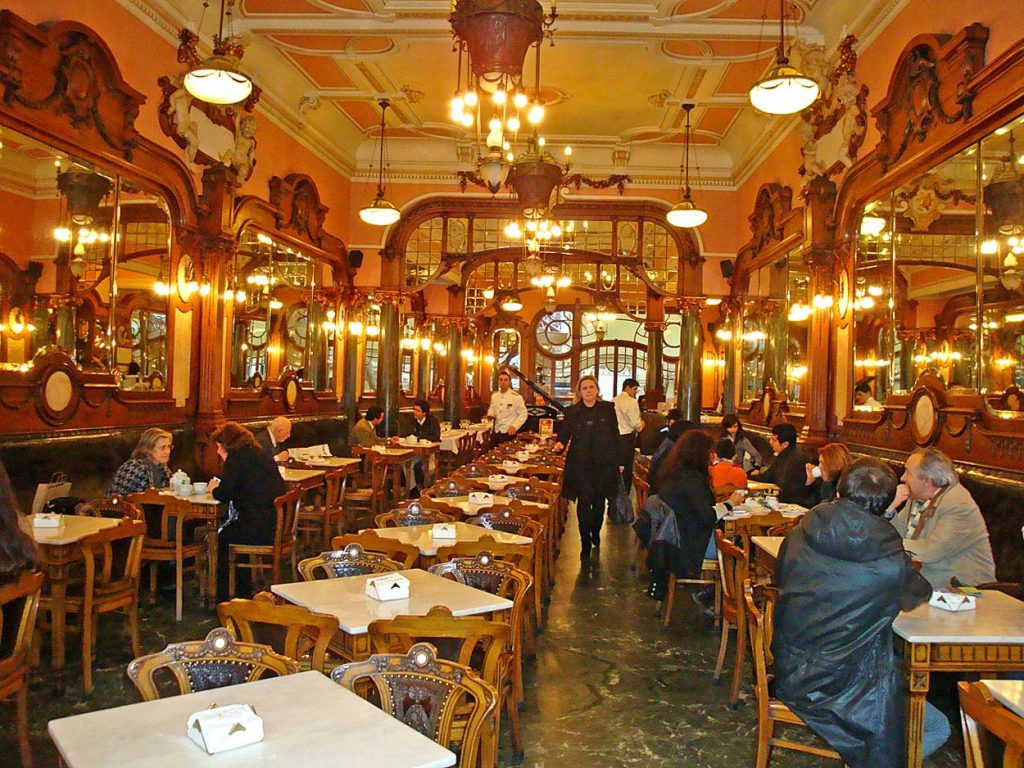
Majestic Cafe is a historic café, located in Rua de Santa Catarina, in Porto, Portugal. Its importance stems both from the cultural atmosphere that surrounds it, in particular the tradition of the ‘rendez-vous café’, where various personalities from the city’s cultural and artistic life meet, as well as its Art Nouveau architecture.
The Majestic Cafe designed by architect João Queiroz, inspired by the work of master Silva Marques, remains as one of the most beautiful and representative examples of Art Nouveau in the city of Porto. Inside, everything is Art Nouveau: the leather seats, the tables, the chandeliers as well as the images of the columns between each mirror, not to mention the paintings on the ceiling and the imposant marble facade adorned with plant motifs.
This place was also where the famous J. K. Rowling worked on her first novel: Harry Potter and the Sorcerer’s Stone. J. K. Rowling left Porto in 1994, but the book was not published until 1997.
- First opened in 1911
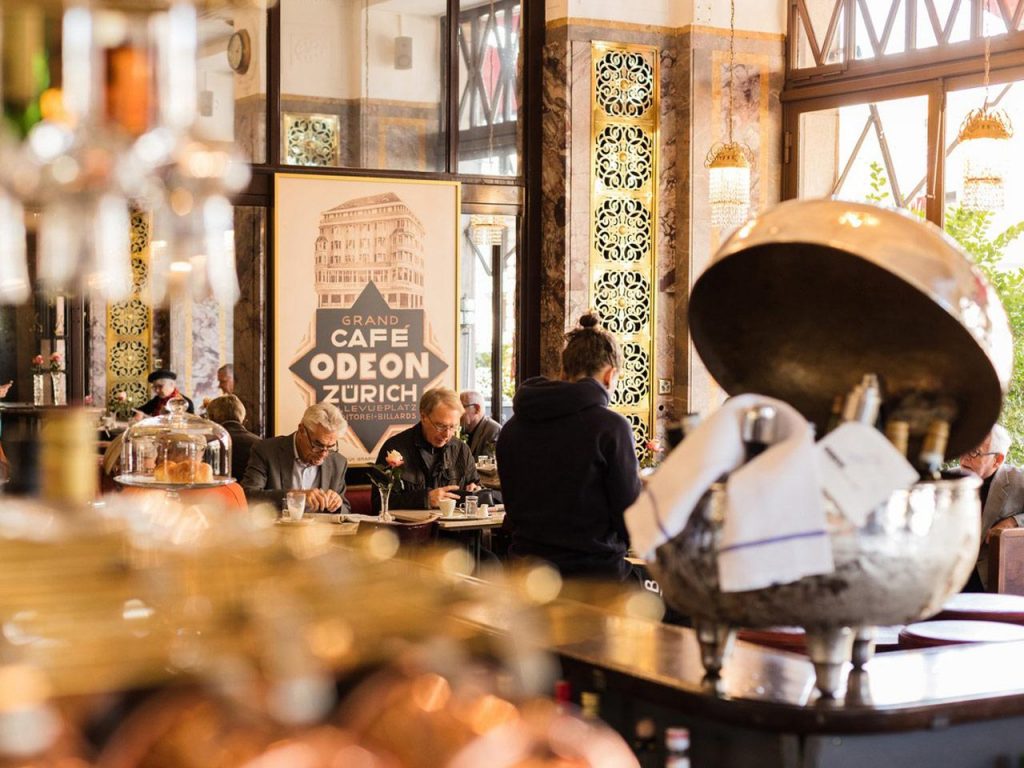
The Grand Café Odeon is a magnificent Art Nouveau Cafe with its own confectionary production in the cellar. The Cafe Odeon is large with high ceilings, large windows, chandeliers, brass cladding, and marble-clad walls. This opulent style is still the hallmark of Café Bar Odeon today.
History has been – and continues to be – written at Odeon. Starting in 1911, the bar was a place where famous politicians, writers, poets, painters, and musicians came to meet. Colonel Ulrich Wille (a General in the Swiss Army in the First World War), Benito Mussolini, Russian revolutionary Lenin, and physicist Albert Einstein all frequented Odeon. During Hitler’s time, Odeon became a kind of ‘center-point for emigrants’. Regulars included Klaus Mann, Alfred Kerr, James Joyce, Friedrich Dürrenmatt, Max Frisch and Rolf Liebermann.
Times have changed – yet tradition remains. Zurich would not be Zurich without Odeon. Guests of all ages and from all social and professional strata come through Cafe Odeon. Early risers, tourists, business people, and night owls all find something on the Odeon menu at any time of the day, and a place to relax. It is also worth mentioning that Odeon was the first place in Zurich that served Champagne – once a luxury drink reserved for the rich – by the glass!
- First opened in 1686
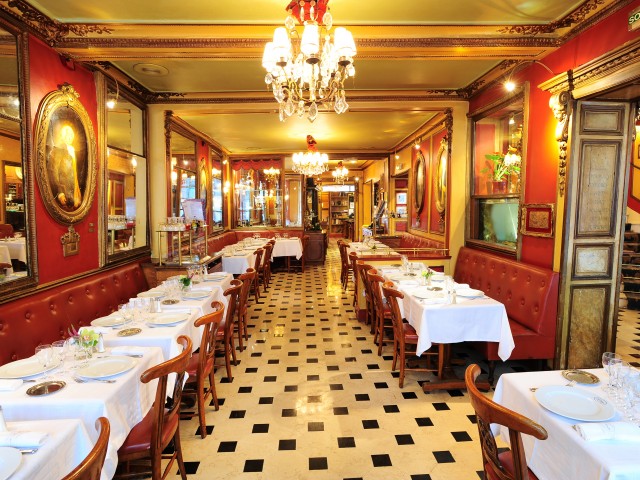
The Café Procope (or simply, Le Procope) was one of the most famous café-restaurants in Paris, founded in 1686. It closed permanently in 1890. However the site is now occupied by a modern restaurant bearing the same name.
It was in 1670 that Francesco Procopio dei Coltelli, a young Sicilian from Palermo, put down his suitcases in France and began a small job as a waiter in a small café in the heart of Paris. Ambitious, a few years later he decided to set up on his own by buying the establishment which he lavishly decorated in order to attract the rich Parisian clientele.
Renamed as Procope, the brand new establishment is quickly becoming one of the capital’s most prominent literary cafes. The greatest writers and intellectuals of the 18th century – Diderot, Voltaire, Montesquieu and d’Alembert – parade at Le Procope, which becomes a real HQ during the French Revolution. Musset and Verlaine composed some of their prose there and the “all of Paris” ended up meeting around the restaurant tables. Le Procope acquired the rank of the largest literary café in the world and for more than 200 years, all those who bore a name or who hoped to make one, whether in the world of letters, the arts or politics, frequented him. The greatest legends were born in this café: Diderot wrote some of the articles of the Encyclopedia between its walls and Benjamin Franklin prepared there the project of Louis XVI’s alliance with the new Republic and would have written there elements of the future. Constitution of the United States.
- First opened in 1862
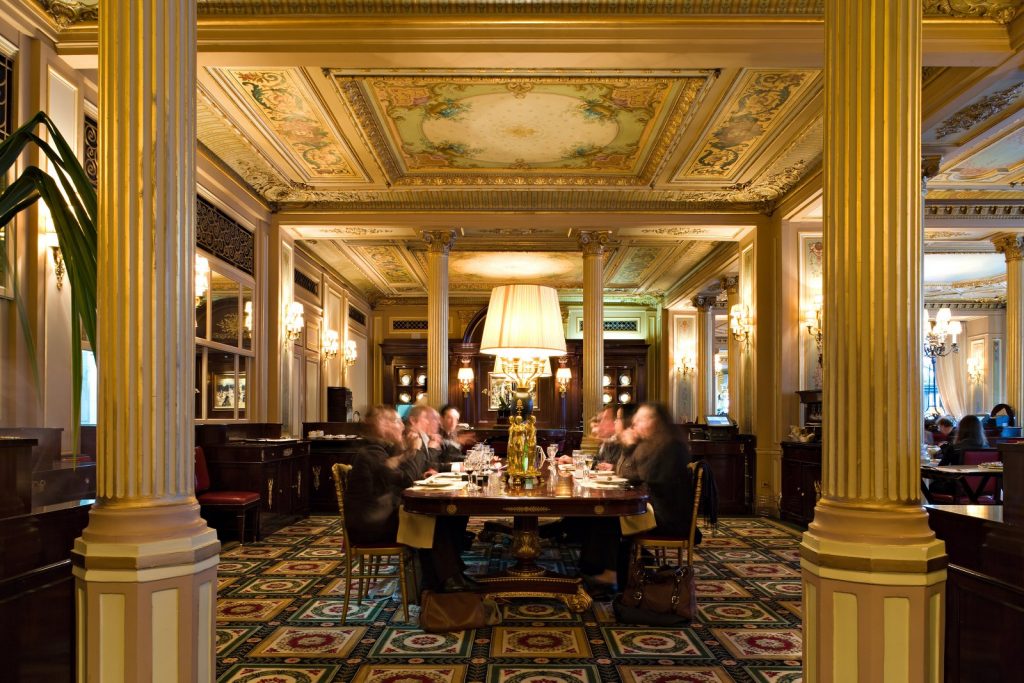
Impossible to remain insensitive to the superb setting of this famous café-restaurant, an elegant and refined café-restaurant… a Parisian palace that some people once knew as the “Grand Hotel”.
The centerpiece of the new Opera district imagined by Napoleon III, this place attracted artists, writers and journalists, theater and opera people, businessmen and travelers passing through Paris.
The world’s first café is said to have been Paris’ Le Procope. It was built by the same architect as the Opera House seen across from it, with an ornate stucco ceiling, gilded walls, and marble tables. Equally monumental are the pastries, often sculpted by local designers.
- First opened in 1793
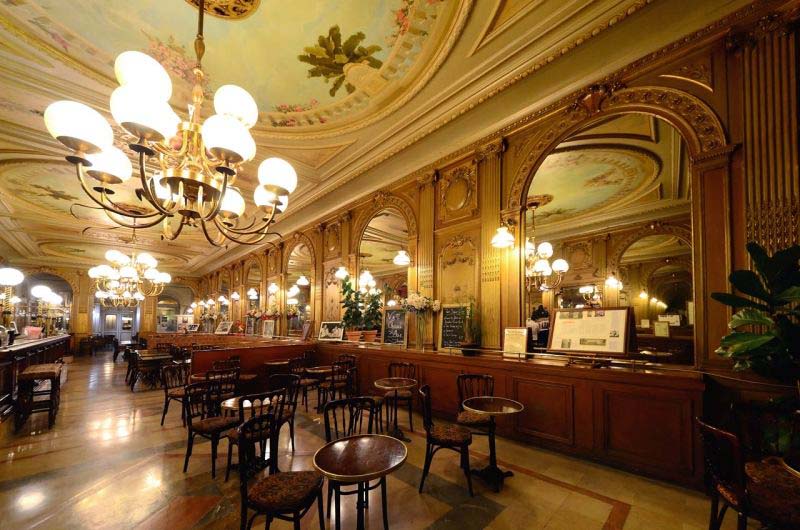
Let’s discover an other café de la Paix! This one is in La Rochelle, created under the name of ‘Military Coffee’, and which has existed under its current name since 1900. It has been classified as a historical monument. The decoration, which includes Empire-style woodwork, ceiling moldings and floral paintings, chiseled chandeliers, large wall mirrors, dates from the early 20th century. If you want to take a break and have a good cup of coffee in the city center. I recommend you this Brasserie. The atmosphere leaves people speechless.
If you are interested by visiting this small port town, please read my previous article on how my 9 tips to optimize your getaway in La Rochelle.
- First opened in 1894
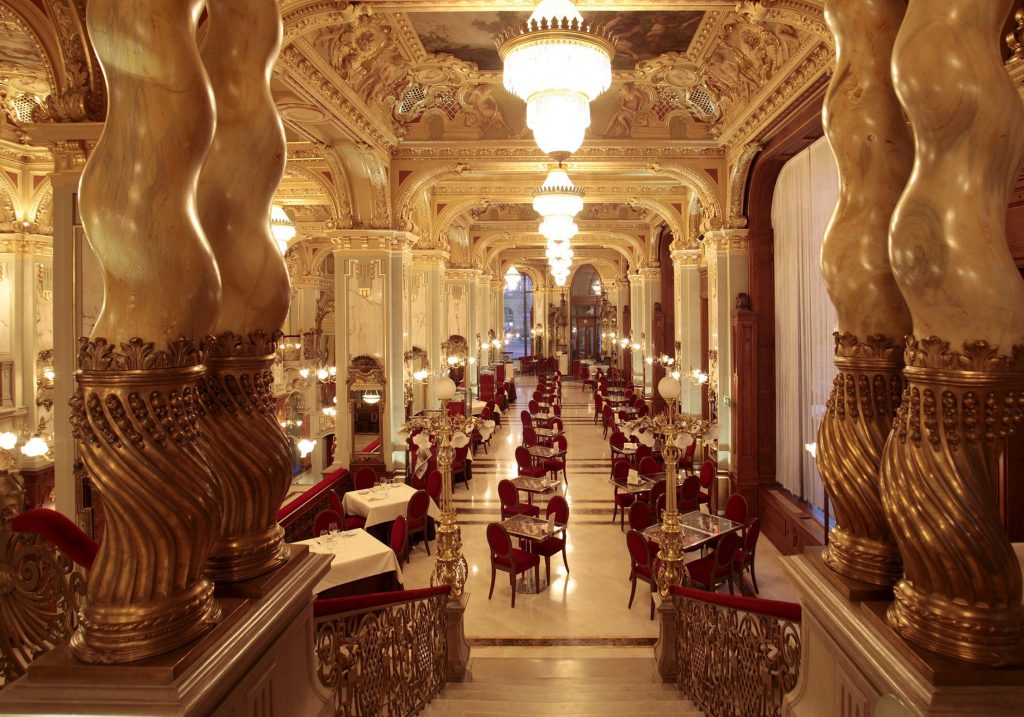
Café New York is often mentioned as one of the most beautiful cafes in Europe – if not the world – and if you happen to visit you’ll probably agree. Renowned for being the place to meet for early 20th century artists, today it’s also a restaurant offering both traditional and Italian dishes to locals and tourists alike. The décor is suitably lavish with elaborate and decorative traditional pieces combined with more contemporary elements. Grab yourself a seat at one of the mirrored tables you may be lucky enough to experience a short performance from the local actors who frequently tread the boards at this popular café.
- First opened in 1876
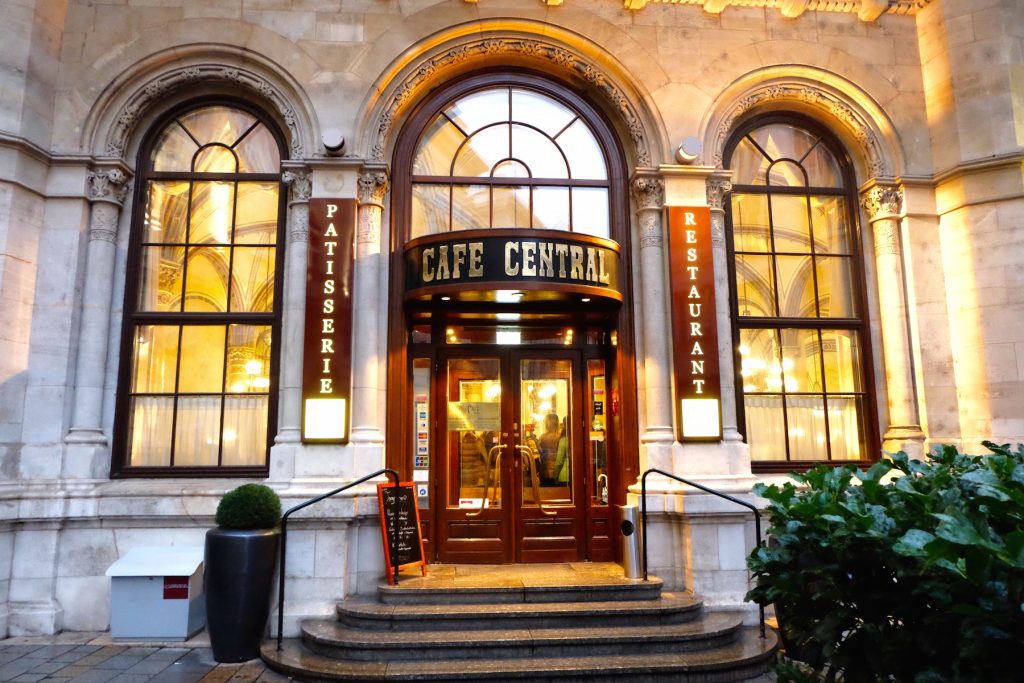
Café Central became, at the end of the 19th century, one of the high places of the Viennese intellectual scene. Its regulars include Peter Altenberg, Theodor Herzl, Alfred Adler, Egon Friedell, Hugo von Hofmannsthal, Anton Kuh, Adolf Loos, Leo Perutz and Alfred Polgar. We also notice, more occasionally and in particular in January 1913, the presence of Sigmund Freud, Josip Broz Tito, Adolf Hitler, Leon Trotsky and Lenin, the last two being regular customers.
Until 1938, the cafe was called Die Schachhochschule (the chess school) due to the presence of many players. The Viennese Positivist Circle held its meetings there before and after the First World War.
At the end of World War II, the café closed its doors. In 1975, the Palais Ferstel was renovated and the Café Central reopened, however in another part of the building. It was completely renovated in 1986 and today is a leading tourist spot and a very popular cafe due to its place in literary history.
If you enjoyed this article and are already thinking about building an itinerary passing by one of the 10 most beautiful cafes in Europe, do not hesitate to contact us our travel adviser on our website!


